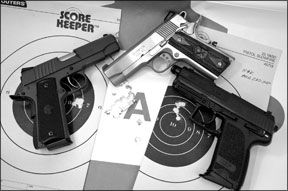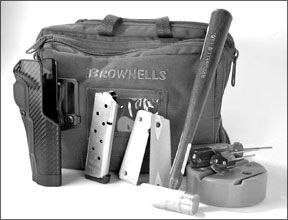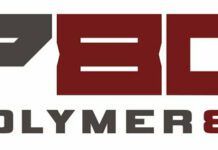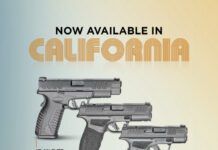The term “single-stack” is a popular nickname for the Browning 1911 pistol that feeds from a magazine, wherein the loaded rounds are stored directly one on top of the other. This vertical column is one of the elements that give the 1911 its narrow grip profile, a key element for stealth carry and a natural index. The flat grip provides instant feedback, telling the operator where the gun is pointing. The 1911 has been chambered for other cartridges, but the .45 ACP is by far the most popular choice. In this test we will evaluate three single-stack 45s that differ significantly from each other and in varying degrees from the original Browning design.

Of our three test guns, the $1011 Springfield Armory Loaded Champion Stainless Steel PX9142LP was the closest to the original 1911 design. But it operated with a plunger-type recoil system that, according to Dave Skinner of STI, was adapted from the patent that was used in the tiny Seecamp pistols. (Our first experience with this recoil system was our test of the STI VIP pistol in the March 2003 issue.)
The Para Ordnance Tac S DCX745E, $969, was designed in response to the perception that double-action pistols are safer than cocked-and-locked single actions. The Tac S featured the Para Ordnance LDA (light double action) trigger but still offered the advantages of 1911-style ergonomics, including a thumb-operated safety. Both the Springfield Armory and Para Ordnance pistols featured all-steel construction.
Our third gun was the Heckler & Koch USP Compact Tactical, $1179. This is an upgraded version of the $919 USP Compact that is now available to civilian as well as law enforcement personnel. Also referred to as the USP45CT, this gun may be carried as a traditional double-action pistol, wherein the first shot is double action, and subsequent shots are single action, or it can be carried cocked and locked for single-action operation. The HK USP45CT pistol was the only gun shipped with an eight-round magazine.
How We Tested
To match firepower with the HK, we used Chip McCormick Power Mags ($25 from brownells.com). Both the Para Ordnance and Springfield Armory pistols ran flawlessly with these 8-shot magazines in place. We also carried the Brownells Field Maintenance Pack for the 1911, $320. This is a complete tool kit for 1911 including a bench block.
Each of our test guns was significantly different in terms of trigger control, so our staff took the time to learn each gun individually before collecting data. Accuracy data was collected by firing single action only from support at a distance of 15 yards. We chose one ful-metal-jacket round and two hollowpoint defense loads for our tests. They were 230-grain FMJ rounds from Federal American Eagle plus 185-grain and 230-grain JHP ammunition from Black Hills.
We also shot each gun at close range in a rapid-fire sequence to gauge target acquisition, control from shot to shot, and trigger reset. Beginning with a ready position of muzzle-forward centered at chest level, we extended to an isosceles hold and fired three shots to the A Zone of a Hoffners ABC16 target (hoffners.com) from a distance of 5 yards. This drill was repeated five times. We recorded total elapsed time using a shot-activated timer from Competition Electronics (cedhk.com). This told us more about each gun’s capability in close-quarters combat. Testing three guns that were so different in operation and feel tempted us to enter into a variety of comparisons. Ultimately, they would be scored by answering the simplest question of all: Would we buy this gun?
Para Ordnance Tac S
DCX745E, $969
The Para Ordnance Tac S distinguished itself from the Springfield 1911 in several ways. For one, it arrived covered with a Spec Ops Green finish accented with black grips. Other black parts were the three-dot sights, beavertail grip safety, left-side-only thumb safety, magazine release and the rear of the extractor as seen from the back of the slide.
The black mainspring housing was checkered and arched to fill the shooter’s palm. The flat-bodied hammer, which was flush fit, was also black. The hinged trigger was mildly polished, and its thin, wispy, profile offered a smooth, rounded face to the trigger finger. The Tac S employed the Para Ordnance LDA, (Light Double Action), trigger system. Slide movement served to pre-load the mainspring so that most of the take-up in the trigger was devoted to simply moving back the hammer. The earliest LDA models were shipped with spurred hammers, tempting shooters to cock the action with their thumb. This caused damage to the LDA system and was partially responsible for rumors that the LDA system was fragile.
Today’s LDA requires that the grip safety be compressed and the slide pulled back to set the trigger. We liked the spurless hammer because, like the rest of this slick gun, it was snag -free and didn’t tear up the lining of our jackets. We noticed that the magazine well was not beveled nor was there a lot of metal left to machine. Adding an external guide attached to the mainspring housing appeared to be the only option for those wishing help in speeding up their reloads.
Removing the top end also required compressing the grip safety. Otherwise it was simply a matter of lining up the notch for the slide release. The Tac S utilized a 4.25-inch ramped barrel with bushing lockup, but we found it easy to manipulate despite the presence of a full-length guide rod. With the slide removed, we saw that the transfer bar was attached to the trigger by slipping over a peg located on an extension connected to the trigger. Here was another source of criticism of the design in earlier models. The slide acted to capture the transfer bar, but with the slide removed, the transfer bar was free to slip off the peg. Despite this being of no real consequence, to some this made the system appear to be weak. But the transfer bar of this model was connected at a point below the frame rail, preventing it from slipping off accidentally. In addition it appeared to us that the gauge of transfer bar was heavier than in earlier models.
Right off the bat we liked the heft of the steel frame and the advantage of having a true on/off switch in the form of a thumb safety. We feel that this is what is missing in so many double-action pistols. Handling the 1911-style thumb safety meant the shooter’s thumb went under the raised lever when off target and rode the top of the safety to help fight recoil when firing.
From the bench the Tac S excelled. Our Para Ordnance delivered a best of test 0.6-inch group from 15 yards firing the Black Hills 230-grain JHP rounds. Average group size was 1.1 inches. Average groups measured 1.3 inches and 1.5 inches across for the 185-grain JHP and 230-grain FMJ rounds respectively. Our test shooters said the Tac S was very easy to hold and point, especially when using an open grip with the strong-hand thumb on the left-side safety. The palm-swell mainspring housing was a big plus in filling the hand. The trigger movement was long, but very light up until the break point. This made it easy to predict.
In our action test we landed all three shot strings inside the A zone in elapsed times ranging from 1.44 to 1.68 seconds (1.56 seconds on average). Our staffers said the long take-up was a hindrance to speed, but in our collective opinion we felt that the delay added to our sense of control. Of the three guns, however, we felt the Tac S transmitted more felt recoil than the others. Also, when the gun was loaded, there was little change in its physical appearance. With the action cocked, the hammer rested just off of the rear of the slide, and the relief in the barrel hood was too brief to act as a visible chamber-loaded indicator.
H&K USP Compact Tactical
USP45CT .45 ACP, $1179
The HK USP (Universal Self-loading Pistol) is probably better

known as a high-capacity pistol double-stack. But when we asked several policeman from different departments along the Gulf Coast which HK pistol they liked best, they named the USP 45 Compact. They favored its light weight, tool-less breakdown, and the way they could get their hands around it. Unwilling to give up shooting a .45, some old-timers chose the USP because even though it was “plastic,” they could at least carry it cocked and locked. “Snapping on the safety instead of decocking offers a higher state of readiness,” said one patrolman.
The new Compact Tactical USP45CT arrived in a ballistic nylon attach case with tool kit. For an additional $160, we also got a longer barrel threaded for suppressor or compensator. Both the standard model and the USP45CT came with barrels that showed stunning mirror finishes in their polygonal bores. Not recommended for shooting lead bullets, the bore showed a twist but was devoid of traditional lands and grooves. The CT barrel also benefited from the fitting of an O-ring to enhance barrel lockup.
Removing the top end only required lining up the relief in the slide and pulling out the slide stop. The guide rod was surrounded by a flat wire spring and a polymer bushing that remained captured. This assembly was removed as a single unit. The barrel was lifted out from underneath instead of through the front of the slide.

Sights on both USP pistols featured a three-white-dot system. We noticed that the detent on the safety of the CT was very heavy, and the move to decock the weapon required some extra pressure as well. The single-action trigger of the CT was noticeably smoother than the one found on a standard USP we also had on hand.
The HK single-column magazine looked wide compared to the magazines from the Springfield and Para Ordnance pistols. The magazine base pad added slightly to the length of the front strap and was removable. This made the magazines easy to clean and to some extent they could be rebuilt. The grip frame of the CT featured extremely thin walls in each side, with an indentation just above the magazine well. This made it possible to grip the magazine and pull it out should it become stuck. The shape of the grip was square compared to most polymer pistols, making the USP45CT easier to point, we thought. The front strap was flat with useful checkering molded in. The back strap offered a palmswell and was also covered with checkering. The grip was angled to undercut the frame above the web of the hand. The decocker/safety lever was found on the left side only, but was reversible for left-handed shooters. We found it safe to ride the safety while shooting because the downward pressure exerted would not activate the decocker. Decocking required a circular counter-clockwise motion.
Magazine release was achieved by pressing downward on a paddle accessible from either side of the trigger guard. Not mounting the release inside the receiver made the grip frame stronger and less bulky. We found that the release could be activated by using the thumb, trigger finger, or middle finger of the strong hand. The CT was the only pistol in the test with an accessory rail. But this design did not include crosshatch lugs, which most attachments require. Surefire does make an adaptor for the HK that adds a Picatinny-style rail (Surefire catalog number MR608, $79).
In our view, the double-action trigger of the USP45CT was too heavy and not nearly as pleasant as its single-action trigger. When we fired the gun from the bench, we were able to land an average size group of about 1.5 inches for all shots fired during our accuracy test. The Heckler & Koch pistol was capable of printing 1-inch groups at 15 yards with every choice of ammunition we tried. Boasting the longest barrel of our trio, 4.5 inches, it also produced the most velocity and power.
Taking into account that the USP45CT could be fired with a double-action first shot as well as full-time single action, we performed our action test twice: Once with the hammer back and safety on, and again beginning with the hammer decocked for a DA first shot.
In either mode, the USP45CT cycled quickly, and the trigger reset was short and easy to find. The sights were highly visible.
Before shooting the USP45CT for speed, we had to find the proper grip. Once we could consistently feel the backstrap seated firmly against our palms, our times plummeted and our groups shrank in size. Members of our staff with larger hands adapted to the HK more quickly.
We should point out that this pistol weighed substantially less than its competitors, but despite this, we thought the HK produced the least amount of felt recoil.
Fired single action only, our elapsed times for landing 15 shots inside the A zone averaged 1.49 seconds. Most strings were completed in the 1.45-second range.
Fired with a double-action first shot followed by two single-action shots, our times ranged from 1.58 to 1.74 seconds. Most strings were completed in about 1.65 seconds. The greater elapsed time was primarily due to the long pull of the first shot. Some of our runs also reflected the natural tendency to dip the trigger on the double-action pull. The results were shots off target low left for right-handed shooters and low right for left-handed shooters.
Springfield Armory Loaded
Champion Stainless Steel
PX9142LP .45 ACP, $1011
The PX9142LP was the smallest of our three pistols. It operated with a ramped barrel that we measured to be 3.95 inches in length. This makes it bigger than the Springfield Armory Ultra Compact model, but shorter than the traditional Commander-length pistols that are midsize 1911s. Atop the stainless-steel slide that featured polished sides, rear cocking serrations, and a frosted top strap were Novak night sights. The frame followed the theme of polished sides and a frosted underside of the dust cover, trigger guard and front strap. This is described as “matte rounds and polished flats” on the springfield-armory.com website. The mainspring housing was not checkered but offered deep lines to aid grip along the back of the receiver.
The trigger was aluminum, relieved for reduced weight, lightly grooved on its face, and adjustable for overtravel. Thumb safeties appeared on both sides of the gun, with the right-side paddle being marginally thinner, favoring the right-handed shooter. The grip safety was oversized above the shooter’s hand and at its base to make sure every size hand would easily deactivate the safety. The hammer was skeletonized and offered serrations for a sure grip. The magazine well was beveled and the Champion was finished with full-width checkered grips complete with Springfield Armory logo and Torx head screws. An internal locking system was discretely placed on the mainspring housing. Two keys were supplied.
The guide rod was sprung by a recoil system that could be described as a shock absorber with two coil springs. The larger of the two springs was removable. It rode over the front of the assembly and was seated inside the guide-rod plug below the barrel at the front of the slide. The other smaller-diameter spring was captured and surrounded the rod at the center of the assembly.
We found that the easiest way to field-strip the Champion was to lock back the slide and slip the small capturing clip over the exposed guide rod. This captured the outer spring inside the guide-rod plug. With the slide stop removed, the top end came off the frame and the recoil unit could be removed as one piece including guide rod, outer recoil spring, and plug. The barrel was removed through the front of the slide.
During reassembly, the recoil system was installed as one piece. Once the top end was applied to the frame, the slide could once again be locked back. The capturing clip was then removed and the slide was free to move forward to complete reassembly. Short slides on smaller 1911s have not always been reliable, but this recoil unit seems to have solved the problem. Keeping track of the supplied capturing clip piece may be the only drawback.
At the range our Champion pistol did not show itself to be as versatile as our other pistols. Printing average group sizes of about 2 inches across at 15 yards is nothing to be ashamed of, but it still lagged behind our other two choices. Clearly the gun favored the heavier, faster bullets, with groups ranging in size from 1.0 to 2.0 inches firing the Black Hills 230-grain JHP rounds. The Champion was listed as operating from a 4-inch barrel, but our measurement was 3.9 inches. As a result, velocity suffered about 20 fps per quarter inch of barrel length when compared to the HK and Para Ordnance pistols.
In our action test, however, the Springfield Armory Champion shined. Elapsed times for our three-shot strings ranged from a fastest overall 1.38 seconds to a 1.52 second initial run (for an average of 1.45 seconds). We also managed to group nine shots into the same 2-inch hole. In terms of numbers we had to agree that results in our action test was close. With practice, each of our test guns were formidable weapons. But we found it faster and more accurate to hold the gun steady and move the Springfield’s trigger a fraction of the distance when compared to the hinged trigger models with longer take-up and reset. This gun cycled very quickly. It was ready to fire well before we were. We’re sure if we had repeated our action test with the Champion our times would have been considerably faster.




























